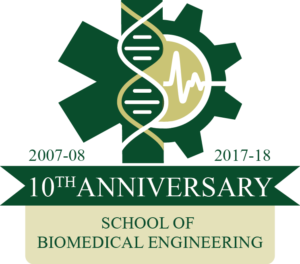A foundation of excellence in four colleges – engineering, health and human sciences, natural sciences, and veterinary medicine and biomedical sciences – represents the interdisciplinary nature of the School of Biomedical Engineering. The school, which has grown from 29 core faculty in 2007 to almost 50 today, celebrates its 10th anniversary this academic year.
“Faculty join from other colleges because of their collaborative interest, and we expand on the basis of collaboration,” said Stu Tobet, director of the School of Biomedical Engineering.
A cauldron of cooperation
Through research and teaching, the school’s vision is to address critical issues in healthcare by bringing together a diverse population of scientists and engineers. Strength is found within these partnerships, as researchers from various disciplines brainstorm about solving unmet medical needs.
When the Scott Bioengineering building was completed in 2012, it provided a focus for the administrative part of the program, and a space for bioengineering research. The building has four interdisciplinary research areas: biomedical engineering, environmental engineering, bioanalytical devices, and systems and synthetic biology. Both faculty and students collaborate on research in each of these areas.
Responding to industry need
The school’s cross-disciplinary foundation lends the program especially well to partnering with industry, which was a driving force behind the creation of the undergraduate program in 2011. The undergraduate program is the first in the state of Colorado to earn accreditation, and has grown to over 400 students. Undergraduate students are required to select two majors, which makes them far more competitive when applying for jobs.
“Industry doesn’t want to hire for biomedical engineering alone,” said Tobet. “The depth of another major makes candidates more desirable.”
Both undergraduate and graduate students are well equipped to enter industry because biomedical engineering is a strongly translational field; researchers are constantly working to engineer solutions to biomedical problems. Some of these solutions are processed as inventions via partnership with CSU Ventures. More than a quarter of inventions disclosed to CSU Ventures were created by biomedical engineering faculty between fiscal years 2013-2017.
“As a student in the program, you know that you have faculty who are not only teaching you, but they also understand how industry works because they’re entrepreneurs, too,” said Allison Robin, business development and marketing manager for the School of Biomedical Engineering.
Focus on faculty
With 10 years under its belt, the School of Biomedical Engineering is adept at responding to the needs of industry, and seeks to continue to grow organically to solve major health care problems prevalent in society. At the heart of past and future successes are CSU faculty across campus, who recognize these needs and are open to working with researchers outside their respective fields.
“The school’s potential is vast because of the way we grow interdisciplinary research,” said Tobet. “Our faculty are highly productive people driving the success of the school.”